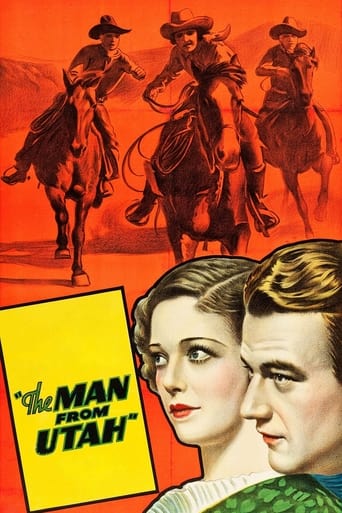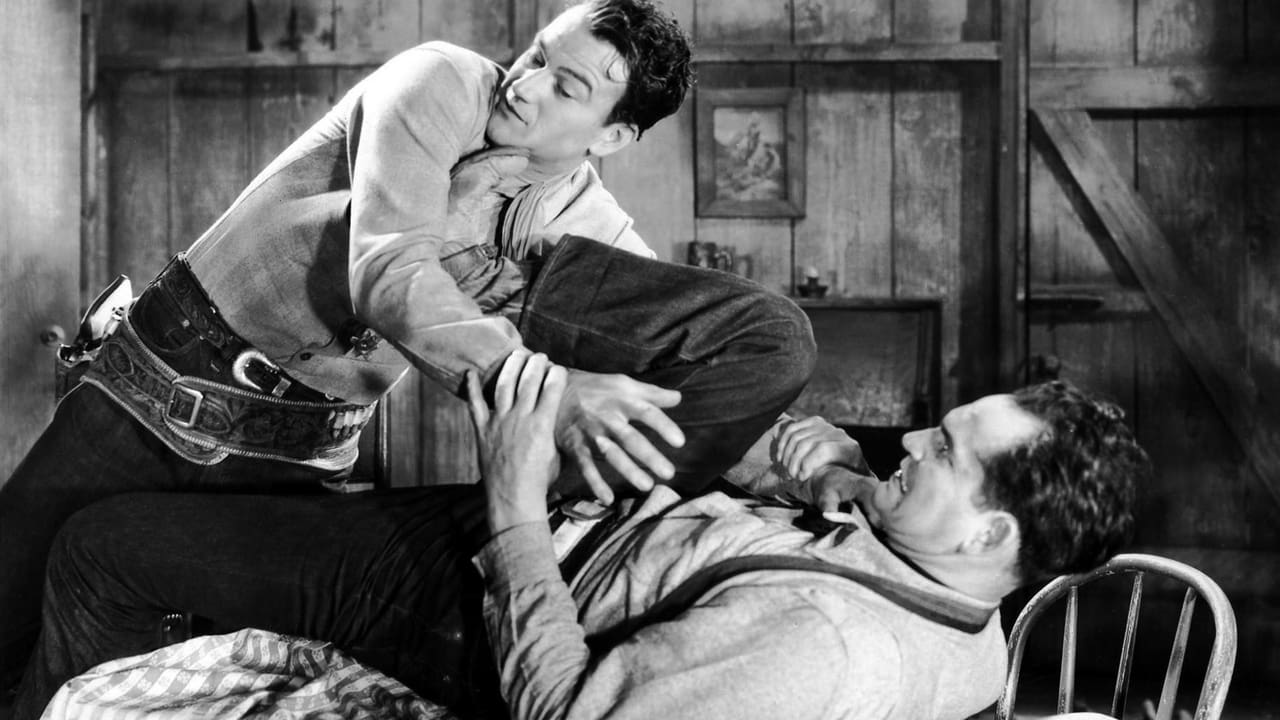Bill Slocum
John Wayne made a number of crummy movies at Lone Star. Trying to decide which was worst is not easy, but "The Man From Utah" is hard to beat.John Weston (Wayne) rides into a new town looking for work, and immediately jumps in to stop a robbery in progress. U. S. Marshal George Higgins (George Hayes, later known as Gabby Hayes) then asks Weston to help solve a series of mysterious rodeo deaths he believes are caused by insiders running the rodeo, whose hired hands always win when these rodeos end in sudden death."It's mighty peculiar that these outsiders fall off those tough broncs sufferin' from snake bite," Higgins says. "I tell you it just ain't natural." That's some mighty fine po-lease work, I tells yuh.Everything about "The Man From Utah" suggests a cut-rate, hurry-up production, more so than the usual Lone Star offerings Wayne made with director Robert N. Bradbury. The movie is slathered with minutes of footage of real rodeo action which seems a decade older than the rest of the film. Parading American Indians, steer roping, stagecoach races, people in stands waving and cheering, it just goes on and on.Wayne is terrible in this one, stiff and wooden. He talks in a monotone and barely seems engaged in what he's doing. A weak script supplies his character with zero motivation to do more. Asked by this guy he never met to go undercover and risk his neck to solve the rodeo mystery, Weston simply smiles and says "Sounds great to me!" without even asking about pay."I'm kind of green at this racket," he says at one point. Green don't cut it here.For some reason, the film introduces Weston on a horse and singing. I think it was him singing, and not the horse, though each seems to lip-sync as well as the other. When Weston reaches town, he puts the guitar behind a tree and the singing never comes up again. Why bring it out in the first place?Padding. It's the reason for the stock footage, too, and a lot of other things in this movie. Take a sequence where Higgins takes Weston to meet a man chopping wood, who then takes Weston to a canoe on a river, whereupon they paddle to a small corral where the guy gives Weston a horse and tells him there's a trail to the town where the rodeo is being held. Why did we need to see all this, if not to fill time? Fifty-two minutes never seemed so hard to fill.Everything is off in this film, from the opening gunfight (everyone including Wayne wave their pistols up and down when firing them, like finger jabs) to the closing battle, where Wayne rides up on two men who shoot and shoot at him, not breaking stride until he jumps off and tackles them to the ground simultaneously.Hayes is fun to watch at times, and so was Polly Ann Young as the pretty love interest, though like everyone else she's saddled with bad dialogue trying to shoehorn a love story in the off minutes. Everyone else plays their parts like rejected extras from a social- disease short.It's hard to rustle much love for this one. Even one of the more positive reviews of this movie notes: "Looking too deep into the story shows its flaws." I second that sentiment, provided "looking too deep" means watching it for more than 90 seconds. "The Man From Utah" is something you don't want to watch unless you are a John Wayne fan, in which case you REALLY don't want to watch it.
FightingWesterner
John Wayne goes undercover at the rodeo to find out what's been killing many of it's event winners. The culprits are a gang of crooked cowboys who want all the prize money for themselves.Another film Wayne made during his tenure as a contract star for Lone Star/Monogram Pictures, The Man From Utah begins with an obviously lip-synced musical performance that I suspect was leftover from his appearance as "Singin' Sandy" in Riders Of Destiny.This is probably a record holder for the amount of times the word "rodeo" (awkwardly pronounced Ro-Day-Oh) is spoken in the same fifteen-minutes!Overall, it's not too bad. There's the requisite amount of riding, though not as much shooting and brawling as usual. There's also some decent rodeo stock footage.One thing that shows the throwaway nature of these type of films in the thirties is the fact that only three years later the same director took the exact same premise and the method of murder (poison needle), re-using it in the Tex Ritter vehicle, Trouble In Texas.
zboston3
This was on a DVD with "West of the Divide", but that flick seems rather primitive, not to mention being taken from a bad print, compared to this interesting and sometimes amusing Wayne Westerner.Among the tidbits are the opening with the unbelievable scene of John Wayne as a singing, dubbed, cowboy; then there's the number of shots where Wayne has an uncanny resemblance to Stan Laurel of Laurel and Hardy; notice the wanted posters outside the marshal's office at the beginning of the film, one of them is for Gat Ganns, the character Wayne pretends to be in "West of the Divide"; and for some scenes Wayne's costume is almost a dead ringer for that of the Lone Ranger (all he needs is a black mask, and the white horse he rode at the opening of the movie).If your expectations are low and you're open to something different, this could be an amusing hour of watching.
Wanted_Man_1
This is pretty dire. Just as Italian opera always kicks off with the tenor blasting out an aria, this horse opera has Big John (in thickly caked make-up) miming pitifully to a recorded voice as he strums a guitar in the saddle. From that wobbly start, the film never really improves.Wayne's character is named John Weston ("western" - get it?) and when he rides into town, he gets involved in the least-convincing shootout you ever saw. Once the basic plot has been established (and believe me, it's basic) what follows is wooden acting and lumbering plot exposition. The film is downright amateurish. When the Duke takes a river trip, instead of cutting from Big John in canoe to the land-based action, the editor gives us the whole laborious process of Wayne disembarking, then clambering up through the undergrowth. The insert of the guy riding shotgun on the stagecoach is oh-so-obviously NOT on the stagecoach. And speaking of "Stagecoach", it is remarkable to note the change in Wayne in five short years. Under Ford's tutelage he grew into a star, and commands the screen in the later film with effortless authority. Here, he is a green amateur.If anything, the movie goes downhill after Weston sets off on his mission. The rodeo is merely an excuse to fill a third of the reel time with archive footage. The opening cavalcade is interminable, and we get the same stock shot of the crowd over and over again. Needless to say, Weston decides to have a go at this cow-wrasslin', and just happens to smash the calf-roping world record. Dolores the fallen woman (Anita Campillo) makes a play for Weston (there always has to be a Fallen Woman in this kind of film - often a latina, too). How come she's Mexican, when her brother isn't? Our hero snubs the judge's daughter, Marjorie (played by Polly Ann Young) in order to make off with Dolores: it is a scene of the ugliest crudity, and woefully underwritten, with Big John wordlessly walking away from the Nice Girl.When director Robert N. Bradbury tries for novel effects, he comes a cropper. The punch-up in a blacked-out room may have seemed like a good idea when the movie was being planned in some Pasadena gin joint, but it fails miserably on the screen. It lasts too long and is too irritating for the viewer. In a medium which relies almost exclusively on visuals, black-out is rarely a smart move. And how did Big John get his white hat on in the dark? Composed of tedious medium two-shots, eschewing close-up altogether, the picture lacks cutting rhythm. If Weston and the Marshall are trying so hard not to reveal their alliance, why are they sharing a hotel room? Why does the gang suddenly decide to snub Dolores? Why did Gabby Hayes get the part of the old-timer? Wasn't Walter Brennan in town? Why is the incidental music so strange? How does Big John know that the bad guys are hiding a needle in the saddle, dipped in snake venom? What kind of idiots would try to commit a series of murders by hiding needles dipped in snake venom in cowboys' saddles? Enough already.


 AD
AD


